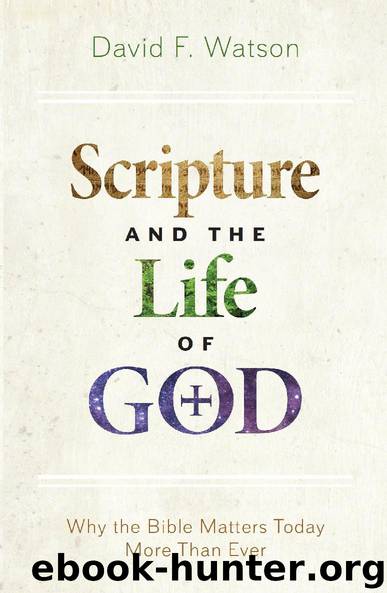Scripture and the Life of God by David F. Watson

Author:David F. Watson
Language: eng
Format: epub
Publisher: Seedbed Publishing
Published: 2017-07-15T00:00:00+00:00
The Bible and the Creeds
At times in the past, Christians have developed short statements of faith to guide believers in their understanding and proclamation of the good news of Jesus Christ. Some churches, such as the Roman Catholic Church, the Orthodox Church, the Anglican Church, and some Methodists and Presbyterians are explicit in their use of the historic creeds. The most commonly used are the Nicene Creed and the Apostles’ Creed. Some Protestant churches, especially those that practice more informal or contemporary forms of worship, have what might be called an “implicit creed.” For example, in these churches, you would likely learn that God is the Holy Trinity, and that Christ was fully God and fully human. These beliefs, summarized for the church in historic creeds, have made their way into the theology of these Christian traditions, even though the creeds themselves have not. Rather than preserving these beliefs in the form of a creed, these communities pass them down through preaching, music, and teaching.
Occasionally I have heard people claim that their church or denomination is non-creedal. I don’t believe that there is any such thing as a non-creedal church. There are churches with implicit creeds and churches with explicit creeds. Every Christian tradition, however, is organized around some set of beliefs that set it apart from other traditions, and the adherents of those traditions generally know what those beliefs are. These beliefs help to shape the ways in which the community of faith understands and applies Scripture.
Why are the creeds important? They are important because they summarize for us the story of God’s saving work on our behalf. This story tells us what God has done in the past, including the creation of the universe, the coming of God’s Son to save us from sin, and his crucifixion and resurrection. It also tells us of what God is doing in the present as the Holy Spirit abides among the community of the church. Finally, it tells us what God is going to do in the future by raising the dead, judging all people, and receiving the faithful into eternal life.
This is the story of our salvation, which has a beginning, middle, and an end. In various forms, it has been preserved to teach Christians about the nature of God and what God has done for us. As Christopher Bryan wrote, “Insofar as our biblical canon as a whole has a ‘matter,’ this creedal story, this Rule of Faith, is it.” 8 In other words, the Bible tells us a story that is summarized in our historic creeds. Insofar as we understand this story, we grasp the central ideas about God’s creating and saving work on our behalf. It is easy to misinterpret Scripture, even if we have the best of intentions, and the creeds help to make good theological sense of what we read in the Bible. 9
The second-century Christian bishop Irenaeus wrote a work called Against Heresies. He was dealing with forms of early Christianity that he felt did not sufficiently express the basic content of the gospel.
Download
This site does not store any files on its server. We only index and link to content provided by other sites. Please contact the content providers to delete copyright contents if any and email us, we'll remove relevant links or contents immediately.
The Lost Art of Listening by Michael P. Nichols(7388)
Why I Am Not A Calvinist by Dr. Peter S. Ruckman(4087)
The Rosicrucians by Christopher McIntosh(3455)
Wicca: a guide for the solitary practitioner by Scott Cunningham(3117)
Signature in the Cell: DNA and the Evidence for Intelligent Design by Stephen C. Meyer(3055)
Real Sex by Lauren F. Winner(2950)
The Holy Spirit by Billy Graham(2880)
To Light a Sacred Flame by Silver RavenWolf(2757)
The End of Faith by Sam Harris(2675)
The Gnostic Gospels by Pagels Elaine(2459)
Waking Up by Sam Harris(2380)
Nine Parts of Desire by Geraldine Brooks(2313)
Jesus by Paul Johnson(2294)
Devil, The by Almond Philip C(2266)
The God delusion by Richard Dawkins(2251)
Heavens on Earth by Michael Shermer(2225)
Kundalini by Gopi Krishna(2127)
Chosen by God by R. C. Sproul(2113)
The Nature of Consciousness by Rupert Spira(2034)
